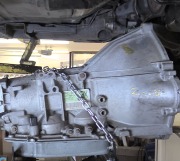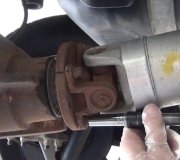Brother Steve gave you a dandy answer, but it may seem incomplete because there are way too many variables, and we do not have enough time left in our lives to type to all the possibilities. You are asking how to do a really major job that a majority of mechanics will not attempt. As a former suspension and alignment specialist at a very nice family-owned new-car dealership, I was asked to do this job thirteen times in ten years to help with a backlog, and I am rather proud to say each job took me less than twice as long as it took an experienced transmission specialist, and that was with the vehicles on a hoist. If you are going to try to do this on the ground, add a minimum of another couple of days to the job.
Steve referred to Mitchell and AllData as the two main online service manual companies that most independent repair shops subscribe to, but my preference is for a paper copy of the manufacturer's service manual. Given the age of the car, there is a good chance you will find that on eBay. It will have ten to fifteen pages of instructions for this job, with a lot of line drawings. Most manufacturers have a section in the back that shows the special tools needed for all transmission work. They do not specify which tools are for which jobs, so there will be a lot related to rebuilding the transmission that will not apply to your job. Much of this job will need to be done by feel, so there is no way to get a camera in there to make the video where you cannot see what you are doing.
As for which hand tools you will need, there is no way to answer that. One person will use a 1/2" ratchet and sockets, from under the car. The next person might use wrenches from on top, under the hood. Once we have some experience with the task and know what has to come apart, we use air tools with whatever short or deep sockets fit best. When the job is new to us, we have to take our time and concentrate on each step. Instead of speeding up with air tools, we take our time with hand tools to give ourselves time to think about the next step.
Both axle shafts go into the transmission, so yes, they both have to come out first. Be aware this is where a lot of do-it-yourselfers cause more problems. The outer CV joints/axle nuts are what holds the front wheel bearings together. There must never be any vehicle weight on the tires when the axle nuts are not tightened to specs. Doing so, even for an instant, can make the bearings noisy. When you tighten them, always use a click-type torque wrench to tighten them to specs. The service manual will have a section in the suspension section of the manual that lists the torque specs. The most common axle nut spec. Is 180 foot pounds, but some vehicles call for as much as 240 foot pounds. Some do-it-yourselfers install the wheel/tire, then set it on the ground to hold the axle shaft from spinning so they can tighten that nut. By that time the damage is already done. Instead, just stick a punch or screwdriver into one of the cooling slots in the rotor to hold the shaft.
Depending on what happened to the old transmission, there is likely to be debris that circulated through the cooling system. Most cars have the transmission cooler in one of the radiator's tanks. That cooler is supposed to be flushed before the lines are connected to the replacement transmission. Most shops have a pressurized flushing machine that uses a special detergent. That is required with a professionally-rebuilt transmission to prevent voiding the warranty. That cooler is not a simple tube running through the engine coolant. It is a tank with a lot of fine passages that get plugged easily. The number of repeated transmission failures can be reduced by replacing the radiator when the transmission needs to be replaced. Most shop owners do not want to saddle car owners with that extra expense, but a professional who has your best interest at heart will at least recommend it and explain why.
If you are installing a used transmission, there is one more thing to watch out for. The torque converter is held in position by the flex plate on the engine. It is going to droop a little when it is unbolted. The front pump has a rubber lip seal that often becomes hardened from age and heat. When the torque converter is not supported while the transmission is loose, it can crack that seal, resulting in a huge leak. The smart thing is to install an new seal while the transmission is out.
Monday, January 29th, 2018 AT 3:28 PM



